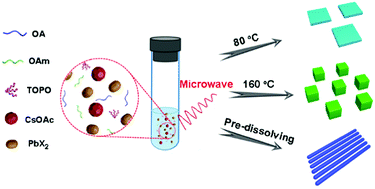Microwave-assisted synthesis of high-quality “all-inorganic” CsPbX3 (X = Cl, Br, I) perovskite nanocrystals and their application in light emitting diodes†
Abstract
As an emerging material for optoelectronic applications, cesium lead halide (CsPbX3) nanocrystals (NCs) have drawn considerable attention because of their excellent photophysical properties. For the first time, we report a fast and efficient microwave-assisted strategy for the synthesis of high-quality CsPbX3 NCs with controllable morphologies (nanocube, nanoplate and nanorod). The prepared CsPbX3 nanocubes show high PLQY, approximately 75%, and narrow full width at half maximum emission line (from 9 to 34 nm) covering the entire spectrum of the visible range. Plate-like and rod-like CsPbBr3 NCs can also be obtained by attenuating the reaction parameters. A feasible kinetics-controlled growth mechanism of such NCs has been proposed and verified. The as-synthesized CsPbBr3 NCs show excellent optical performance as a green light source in a white light emitting diode prototype device. This work not only provides a new synthetic path for the preparation of high-quality CsPbX3 NCs, but also sheds some light on the fundamental study and practical applications of such NCs.

- This article is part of the themed collection: 2017 Journal of Materials Chemistry C HOT Papers


 Please wait while we load your content...
Please wait while we load your content...